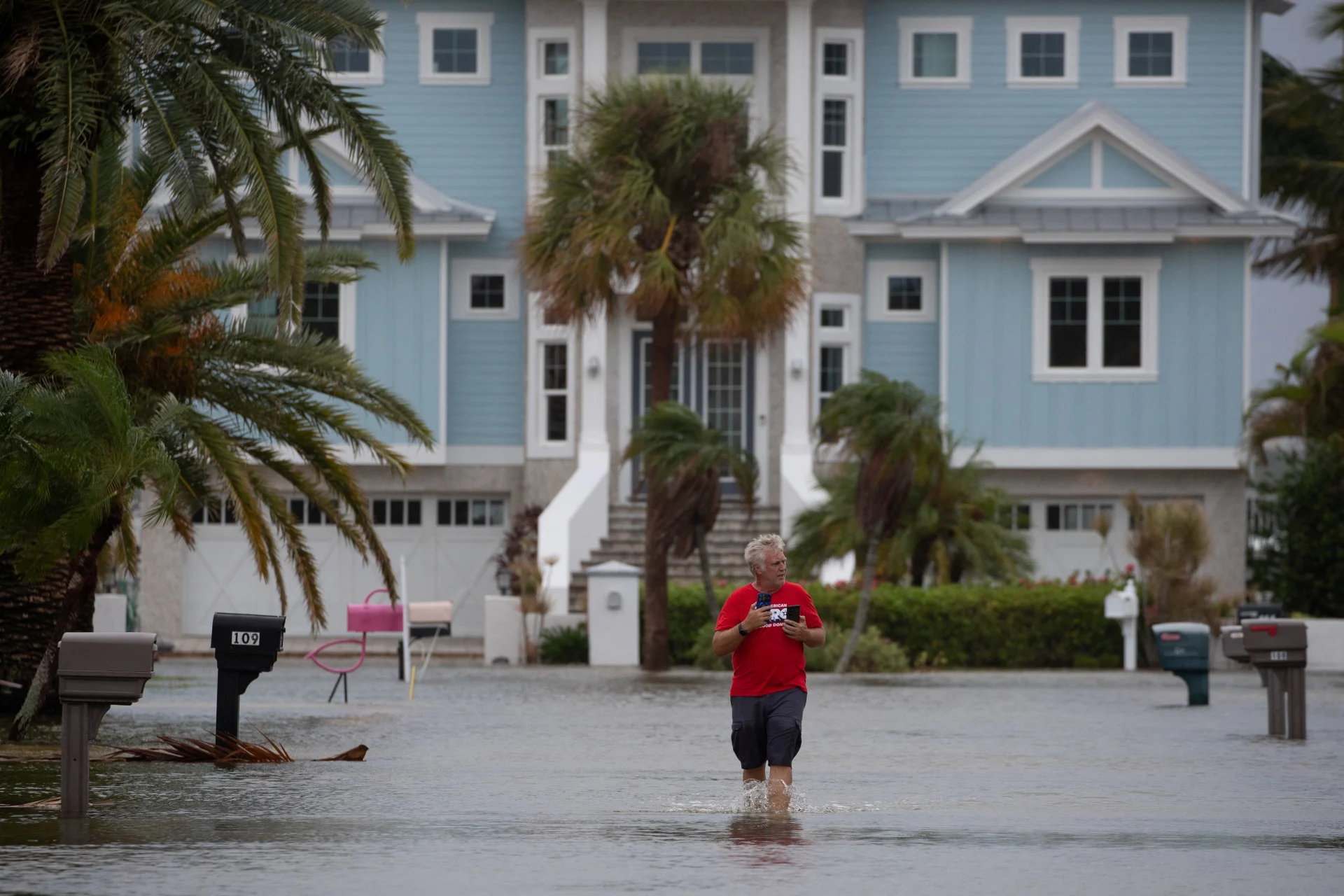
Category 3 Hurricane Idalia slams ashore at Florida's Big Bend
Visit The Weather Network's hurricane hub to keep up with the latest on tropical developments in Canada and around the world
By Maria Alejandra Cardona and Marco Bello
STEINHATCHEE, Florida (Reuters) -Hurricane Idalia made landfall in Florida as an "extremely dangerous" Category 3 storm on Wednesday after millions of residents evacuated or hunkered down in homes and shelters in anticipation of a life-threatening storm surge.
Drawing strength from the Gulf of Mexico's warm waters, Idalia unleashed destructive winds and torrential downpours that were forecast to cause coastal flooding up to 16 feet (4.88 m) deep along the state's Gulf Coast.
Idalia came ashore at 7:45 a.m. EDT (1145 GMT) at Keaton Beach, an ocean-front community of 13,000 people in Taylor County, about 75 miles (121 km) southeast of Tallahassee, the state capital. The town lies in the center of the Big Bend region, where the state's northern panhandle curves into the Florida Peninsula.
"It's just ripping through Taylor County now. Hope all is safe," County Commissioner Jamie English told Reuters. "Winds gusting. Terrible power outages all over. Debris flying everywhere."
Video footage from Keaton Beach posted on social media platform X by storm chaser Sidney Grimmett showed heavy downpours and trees whipping in the wind as an electrical line sparked along the side of a roadway.

A general view of heavy rains and flooding, caused by Hurricane Idalia, in Tampa Bay, Florida, U.S. August 30, 2023, in this screen grab taken from a social media video. (@lizpalmer44 via X/via REUTERS)
RELATED: The curse of storm nine: Why so many “I” hurricanes are monsters
Overnight, Idalia attained "an extremely dangerous Category 4 intensity" on the five-step Saffir-Simpson wind scale on its way to landfall in Florida Wednesday morning, the National Hurricane Center (NHC) in Miami said.
But by 7 a.m. EDT (1100 GMT) it weakened slightly, slipping into Category 3, with maximum sustained winds of 125 mph (201 km). Any storm reaching Category 3 or higher is considered a major hurricane.
Sparsely populated compared with the Tampa-St. Petersburg area to the south, the Big Bend features a marshy coast, threaded with freshwater springs and rivers, and a cluster of small offshore islands forming Cedar Key, a historic fishing village demolished in 1896 by a hurricane's storm surge.
Early Wednesday morning, storm winds were knocking bent palm tree tops against Ken Wood's house in Dunedin, near Tampa and 185 miles south of landfall.
Wood, 57, a bridge tender in Pinellas County, did not heed evacuation orders even after he shut down the bridge between on the Dunedin Causeway on Tuesday, saying he figured he was on high enough ground.
"Mainly it's a lot of loud wind and rain right now, some thunder," he told Reuters by telephone, adding that roads were flooded. "The sky is dark."
WATCH NOW: Stormhunter dodges debris live on camera as Hurricane Idalia hits Florida
Danger to life
Most of Florida's 21 million residents, and many in the adjacent states of Georgia and South Carolina, were under hurricane warnings and other storm-related advisories. State emergency declarations were issued in all three.
Florida's Gulf Coast, southeastern Georgia and eastern parts of North and South Carolina could face 4 to 8 inches (10 to 20 cm) of rain through Thursday, with isolated areas seeing as much as a foot of rain (30 cm), the hurricane center warned.
Officials said the storm's most dangerous feature would be a powerful surge of wind-driven surf that is expected to flood barrier islands and other low-lying areas along the coast.
Surge warnings were posted for hundreds of miles of shoreline, from Sarasota to the sport fishing haven of Indian Pass at the western end of Apalachicola Bay. In some areas, the surge could rise as high as 16 feet (4.9 m), the NHC said.

A resident drives past a fallen tree due to the high winds from Hurricane Idalia in Clearwater, Florida, U.S., August 30, 2023. REUTERS/Adrees Latif
SEE MORE: How hot water fuels the world’s most powerful hurricanes
"If you end up with a storm surge that even approaches 16 feet, the chances of surviving that are not great," DeSantis said. "You would need to be in a three-story building because it is going to rise very, very high."
At the White House on Tuesday, U.S. President Biden said he and Florida Governor Ron DeSantis, who is seeking the Republican nomination to challenge Biden in the 2024 presidential election, were "in constant contact" about storm preparations.
Biden was set to speak about the government's hurricane response efforts later on Wednesday.
Idalia grew from a tropical storm into a hurricane early on Tuesday, a day after passing west of Cuba, where it damaged homes, knocked out power, flooded villages and prompted mass evacuations.
It was the fourth major hurricane to strike Florida in the past seven years, following Irma in 2017, Michael in 2018 and Ian, which peaked at Category 5, last September.
More than 40 school districts in Florida cancelled classes, DeSantis said, and Tampa International Airport suspended commercial operations on Tuesday.
About 5,500 National Guard members were mobilized, while 30,000 to 40,000 electricity workers were on standby. The state has set aside 1.1 million gallons of gasoline to address interruptions to fuel supplies, the governor said.
RELATED: Canadian snowbird watches door cam as Hurricane targets Florida home
Thumbnail courtesy of Adrees Latif/Reuters.
This article was originally published for Reuters. (Reporting by Maria Alejandra Cardona in Steinhatchee, Florida, Marco Bello in Cedar Key, Florida, Joey Roulette in Tampa, Florida, Rich McKay in Atlanta, Nelson Acosta in Havana, Dave Sherwood in Guanimar, Cuba, Brad Brooks in Longmont, Colorado, Brendan O'Brien in Chicago and Nandita Bose in Washington; Writing by Steve Gorman; Editing by Gerry Doyle and Bernadette Baum)









